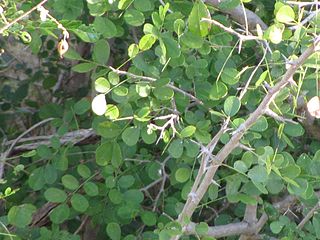
Dalbergia melanoxylon is a flowering plant in the family Fabaceae, native to seasonally dry regions of Africa from Senegal east to Eritrea and south to the north-eastern parts of South Africa. The tree is an important timber species in its native areas; it is used in the manufacture of musical instruments and fine furniture. Populations and genomic resources for genetic biodiversity maintenance in parts of its native range are threatened by overharvesting due to poor or absent conservation planning and by the species' low germination rates.
Dalbergia annamensis is a species of legume in the family Fabaceae. It is found only in Vietnam. It is threatened by habitat loss and agent orange.
Dalbergia balansae also known as Dalbergia assamica is a species of legume in the family Fabaceae. It is found in China and Vietnam. It is threatened by habitat loss.
Dalbergia baronii is a species of flowering plant in the legume family Fabaceae. It is endemic to Madagascar. It is named after the English missionary and botanist Rev. Richard Baron.
Dalbergia bathiei is a species of legume in the family Fabaceae. It is found only in Madagascar. It is threatened by habitat loss.
Dalbergia bojeri is a species of legume in the family Fabaceae. It is found only in Madagascar. It is threatened by habitat loss.
Dalbergia capuronii is a species of legume in the family Fabaceae. It is found only in Madagascar. It is threatened by habitat loss.
Dalbergia delphinensis is a species of legume in the family Fabaceae. It is found only in Madagascar. It is threatened by habitat loss.
Dalbergia funera is a species of legume in the family Fabaceae. It is found in El Salvador and Guatemala. It is threatened by habitat loss.
Dalbergia hirticalyx is a species of legume in the family Fabaceae. It is found only in Madagascar. It is threatened by habitat loss.
Dalbergia intibucana is a species of legume in the family Fabaceae. It is found only in Honduras.
Dalbergia louvelii is a species of legume in the family Fabaceae. It is found only in Madagascar. It is threatened by habitat loss.
Dalbergia maritima is a species of legume in the family Fabaceae; it is a rosewood, and its wood is often referred to as Bois de Rose. It is found only in Madagascar. It is threatened by habitat loss due to the over-consumption of its species.
Dalbergia monticola is a species of flowering plant in the legume family Fabaceae. It is endemic to Madagascar. It occurs at higher elevation, which gave the species its name.
Dalbergia normandii is a species of legume in the family Fabaceae. It is found only in Madagascar. It is threatened by habitat loss.
Dalbergia oliveri is a species of legume in the family Fabaceae which grows in tree form to 15 – 30 meters in height. The fruit is a green pod containing one to two seeds which turn brown to black when ripe. It is threatened by habitat loss and over-harvesting for its valuable red "rosewood" timber.
Dalbergia pseudobaronii is a species of flowering plant in the legume family Fabaceae. It is endemic to Madagascar. Its leaves are similar to those of Dalbergia baronii, which gave the species its name.
Dalbergia simpsonii is a species of legume in the family Fabaceae. It is found only in Peru.
Dalbergia tsaratananensis is a species of legume in the family Fabaceae. It is found only in Madagascar. It is threatened by habitat loss.
Dalbergia urschii is a species of legume in the family Fabaceae. It is found only in Madagascar.

